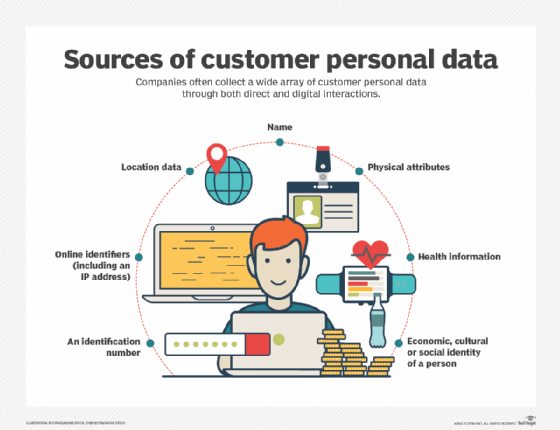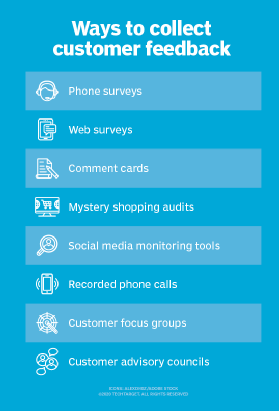CX personalization: Why it's important and how to deliver it
A personalization strategy can increase brand loyalty and customer retention by providing relevant content to customers when they need it. Here's how to get started.
Customers no longer tolerate irrelevant emails and advertisements. Instead they expect brands to understand and anticipate their needs, then tailor their experiences to them.
That's why personalization is often a make-or-break factor in customer experience. Personalization approaches fall into the following three categories:
- Explicit personalization. This relies on a brand knowing the types of services or products consumers are interested in based on those users telling the company something about them, such as age, geographic location, sports, hobbies, food or vacation interests. Brands can collect this data in a variety of ways, including surveys and loyalty program signups.
- Implicit personalization. This is when a brand infers the types of services or products users might be interested in based on their behavior, such as browsing histories. The brand can also rely on other sources of information, such as a CRM system or sales order system that can record previous purchases. The inference can also come from input sources for demographic data, assuming the brand can place users in a specific demographic category.
- Contextual personalization. This infers the relevant types of services or products for users with information such as location or time. For example, computers and smart devices can use GPS or Wi-Fi to provide approximate locations. Sensors such as Bluetooth beacons can provide a more exact location.
For successful CX, brands must know how to effectively personalize the customer experience.
What is a personalized customer experience?
Customer experience personalization is about designing products and services to meet customers' individual needs and matching them with those offerings.
Brands can implement targeted advertisements when they understand customers, including their previous buying trends and demographic data points, such as age, gender, income level, race, employment, location, homeownership and level of education. Demographic data can encompass all characteristics of the buyer, including preferences, hobbies and lifestyle choices.
For simple personalization, businesses can add a "buy again" link or button on their e-commerce websites. If customers previously bought an item, they are likely to buy it again. Timing is also crucial. Customers are even more likely to purchase the item again if the product recommendation matches a known buying pattern, such as replenishment cycles of a consumable item. For example, if customers replenish their laundry detergent monthly, a well-timed targeted ad a month after the last purchase will hit the mark. Ineffective timing, however, could annoy customers -- unless it is incentivized.

A more complex example of personalization is a teaser ad recommending a pension plan or healthcare product. Here, relevant factors include the customer's age, income, knowledge of preexisting policies and medical conditions.
Why is a personalized customer experience important?
In an increasingly commoditized world, a brand's CX -- rather than its product or service -- is the differentiator. If at least two suppliers have the same or a similar offering, then organizations must strive to deliver superior CX. A customer's experience strongly influences brand loyalty, which then influences customer retention. Personalization serves as a key part of the customer experience to differentiate businesses from competitors as well as to both attract and retain customers.

"Personalization and personalized experiences are table stakes … Customers expect to be provided with relevant content, information and recommendations based on their preferences and behavior," said Mary Schneeberger, managing director and studio lead at Avionos, a digital transformation consultancy.
In recent years, personalization has evolved from solely using demographic data to also using past experiences, including purchases and content that engages customers.
"Personalization previously meant sending a targeted recommendation as a follow-up email or providing that personalized, on-site experience when someone returned to the site. But now it's all happening in real time," Schneeberger said. Personalization requires real-time offer management and generative AI to provide the dynamic content that can create better experiences.
Effective personalization is a major contributor to positive CX. If brands use data from customers' previous behaviors and demographic information, they can personalize recommendations to help increase engagement and retention.
Personalization is relevant for both face-to-face and online transactions. A customer who walks into a hotel will likely have a better experience if the receptionist is aware of that person's previous stays, dining preferences, newspaper deliveries or reservations at the spa. For example, the receptionist can automatically reserve customers a massage with a masseuse they previously visited.
12 steps for customer experience personalization
For proper customer experience personalization, CX teams must collect and segment customer data to truly understand their current and potential customers. Then they should know how to act on that knowledge.
Brands can begin building a personalization strategy with these 12 steps:
1. Build, manage and maintain customer profiles
CX teams should source data from a corporate CRM system and make it easy for customers to create and maintain their own profiles. Then teams should regularly review and clean profile data to refine profiles at every touchpoint.
2. Define and implement customer segmentation
Brands should divide current and potential customers into groups or segments, each with defined characteristics. Those may include comparable demographics and geolocation; communication methods, like email, social media, text and voice; and relevant targetability. However, CX teams shouldn't define a segment if no target product or service is applicable to it. Segments should have longevity, with slowly changing characteristics that continue to generate revenue.
3. Catalog product and service characteristics
Brands should define characteristics of products or services that match the characteristics of customer profiles. For example, customers that hike may be interested in small-dimension, lightweight equipment, such as chairs, tents and stoves. Customers that attend open-air festivals could also match that product characteristic. Customers who want that type of equipment may become frustrated if an online store does not enable searches and comparisons of those characteristics.
4. Create a personalization rule base
The rule base is the logic used to marry the characteristics of the customer segment with characteristics of the product and service. Some examples include matching hikers with appropriate hiking equipment.
5. Establish loyalty programs
Brands should define how to encourage customers to complete their profiles, return for repeat business and be incentivized to respond to offers. Loyalty programs can check all those boxes.
6. Plan the messaging strategy
Personalized messages can help brands cut through the clutter that customers receive daily. Brands should use a customer's name in communication and refer to previous activities, such as holiday destinations or purchased goods and services. This reminds customers how good they felt and acts as a segue to new service or product offerings.
7. Enable self-service options
Self-service channels enable customers to change their preferences and behaviors easily and quickly. For example, customers can use self-service channels to change the reordering schedule for household items, which gives brands a more accurate view of their behaviors. Self-service options also let customers -- and, by extension, brands -- more easily maintain and update addresses and contact details. Helping customers service themselves without calling customer support also offers them a faster turnaround.
8. Integrate with social media
Personalization is critical at every customer touchpoint, including emails, phone calls and online chat. Each touchpoint provides more information to refine a customer's profile, thus improving personalization. Social media platforms offer additional touchpoints. Brands can take advantage of those platforms for more insights to improve customers' profiles.
9. Incorporate and support customer feedback
Organizations must make it easy for customers to provide feedback, which generates more accurate personalized experiences. Brands can act on customer feedback and refine their segments to further personalize marketing content.
10. Align the organization around the customer
Brands should centralize and analyze customer data and interactions, such as feedback, social media posts, contact center conversations, transaction history and review ratings. Then the CX team should define a corporate strategy to support personalization initiatives and align it with business goals.
11. Analyze customer behavior trends to adapt to changes
Brands that treat customer preferences as static find their messaging can quickly become irrelevant due to rapid changes in trends. Don't assume past approaches to loyalty will continue to drive customer growth in the future.
12. Consider profile personalization
The industry has traditionally focused on supporting 1:1 personalization. However, many successful personalization programs achieve good results without the scaling headaches and privacy challenges inherent in individual personalization.
Tools to support personalization initiatives include CRM systems, personalization engines, link tracking and analysis, survey engines and data analytics.
6 common pitfalls of personalization efforts
While personalization can benefit both customers and businesses, it also brings forth a handful of challenges. Those include the following:
- Legislation. Personalization relies on the collection and manipulation of personal data. Concerns over privacy and data usage are increasing and reflected in new legislation. Organizations must consider certain regulatory requirements, such as GDPR and the use of third-party cookies, when collecting customer data. Brands should always involve their compliance and regulatory teams in a personalization project.
- Distributed and disconnected systems. Data silos make it difficult to aggregate the personalization data for analytics. Companies that lack strategic data warehouse initiatives should consider this approach to support the CX team's personalization efforts.
- Organizational silos and unclear roles. All departments must work together to fully understand customer touchpoints and how personalization can benefit each stage in the customer journey. Silos can prevent brands from gathering the right customer data. For example, if the e-commerce team works independently from the brick-and-mortar sales team, or if sales and marketing teams have disjointed communications, personalization efforts become more complex from technology integration to company and brand integration.
- Waterfall project mentality. Tackling large personalization projects in a Waterfall approach -- a rigid, structured methodology -- rather than a smaller, iterative Agile approach can create challenges for a personalization project. CX teams should seek to improve personalization techniques frequently and validate the best approaches with A/B testing.
- First-time customers. During the initial touchpoint with a new customer, a brand knows nothing about that individual. Its goal is to create a customer profile and retain that customer, so it should enable customers to start profiles on their own. For example, at checkout, a simple checkbox for consent can enable companies to potentially harvest address details and preferences around contact mechanisms.
- Poor data quality. The quality of customer data defines the effectiveness of the personalization. The best data comes directly from the customer, according to Colson Hillier, CMO at Alorica, a business process outsourcing consultancy. This data includes buying patterns, preferences and interests. If the information is not from reliable sources or comes from a third-party vendor, it can be misguided or completely off target.
Real-world examples of personalized CX
Brands can measure personalization's success based on whether customers find it assistive or intrusive.
Many customers view Netflix's recommendation engine as assistive personalization. Two key aspects of Netflix's strategy are the landing cards -- images users view when they scroll through content -- and the "because you watched" recommendations. The landing cards offer an easy, simple way to view content and entice the customer to watch a certain program. The ease of scrolling through these landing cards creates an intuitive UX. The "because you watched" recommendations can result in users enjoying shows and movies more often, which generates positive CX.
Netflix uses two major components to feed the recommendation algorithm: customer profiles and product data. The customer profile can include viewing history, personal movie ratings, time of day for watched movies, the viewing devices and how long a customer watched the program. The product data includes movie or TV show characteristics, such as genre, category, actors, release year and similarities with other products.
Another common application of assistive personalization is discounts or rebates in customer loyalty programs, which are popular among grocery stores and consumer goods organizations. This approach can bring in repeat business, as it encourages customers to spend a certain amount or buy a certain item to receive the discount. It also helps brands understand purchase frequency and spend thresholds to craft appropriate messaging and discounts across channels.
Another example is rewards programs, which airlines and hotels often use to encourage returning customers. Rewards can include points that customers can use to pay for a hotel room or flight or exclusive membership opportunities, like Delta Sky Club, which has VIP offerings for members.
"Finding the right balance of community, delight, ease, uniqueness and value is paramount when creating a loyalty program with the flexibility to satisfy a diverse clientele," Herndon said.
Most consumers don't mind relevant ads but may feel overwhelmed, interrupted and stalked by too much personalization. Many users view Facebook as an example of intrusive personalization. In 2018, Facebook broke the trust of many of its customers when news revealed that the company allowed Cambridge Analytica to harvest personal data without consent. Personalization is effective when done right, but it can easily disturb customers.
Editor's note: This article was originally written by Jonathan Bordoli and expanded by George Lawton.






